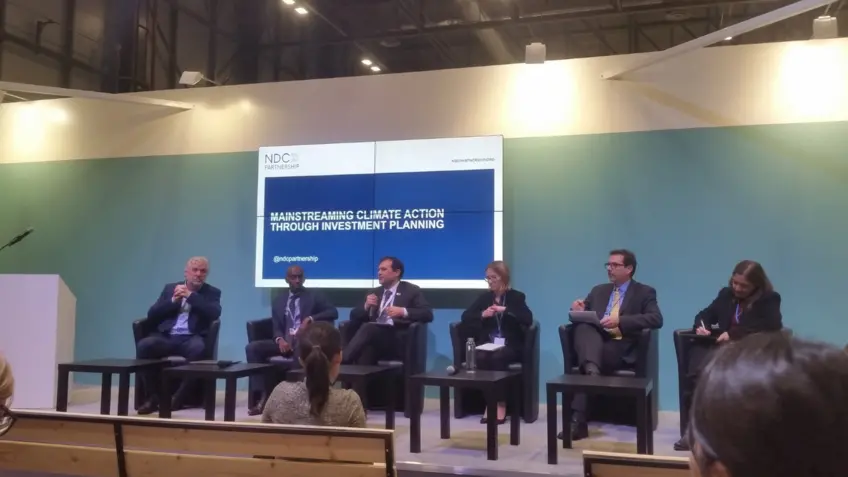Four Lessons on NDC Investment Planning from COP25
The NDC Partnership Support Unit hosted its first official COP25 side-event on 4 December centered on strengthening the understanding of NDC Investment Plans and methods for unlocking finance.
Support for NDC investment planning is the most requested area for finance-related support (46 percent) among NDC Partnership countries. To address this need, the Partnership convened a panel of six climate finance experts to exchange perspectives on questions frequently encountered regarding NDC investment: What defines an NDC investment plan? How do they relate to other national plans? How should they align around common investment criteria to assess and prioritize proposed project pipelines?
Based on the panel, four key lessons emerged that countries looking to undertake NDC investment planning should consider:
Lesson One: NDC Investment plans are a process, not a template
In opening remarks, Swedish Minister of International Development Cooperation, Minister Peter Eriksson, underlined the importance of investment plans in aligning public spending decisions with NDCs and subsequently identifying funding gaps which may be filled by international financiers. Dr. Amal-Lee Amin, Chief of the Climate Change Division at the Inter-American Development Bank (IDB), emphasized that this is a process that differs for each country, and that a one-size-fits all approach doesn’t exist.
Dr. Amin also laid out three important stages in the process of crafting an effective plan: 1) national-level public budget prioritization; 2) identifying international public finance to fill gaps where needed; and 3) providing a pathway to engage with private sector investors over time.
Lesson Two: Don't underestimate the importance of national planning and budgeting
Mapping out domestic budget priorities is vital to integrating NDC-related actions into government spending and enables governments to make informed and transparent “green” investments. Starting with long term development goals and working backwards to identify key objectives, priorities, and sectors can allow countries to prioritize NDC actions for investment and evaluate the cost and benefits of implementation. Mr. Bright Ntare, CFO of the Rwanda Green Fund, explained, “In the first instance, the question must be: what can the government support? And then the second question is: what are the gaps?”
This integration also requires close cooperation between ministries, especially with ministries of finance. Bringing ministries of finance and planning into the conversation as early as possible is crucial as they decide where public expenditure gets allocated and can identify gaps where external financial actors may step in. Once an investment plan is translated into a project pipeline, networks like the NDC Partnership can work with investment partners and member countries to fill funding gaps.
Lesson Three: Country ownership can drive international investment
Government owned NDC investment plans can create visibility as strong national ownership builds confidence with investors. Stephen Hammer, Manager of Climate Policy of the World Bank, highlighted that governments that articulate their vision for turning climate priorities into project pipelines can bring investors to the table and work with them in a consultative way to:
- Help mitigate uncertainty and perceived risks by increasing coordination with national financing bodies
- Clarify what the government can do from a regulatory perspective to enable investment
- Identify mechanisms, like national funds or blended finance, that can provide capital the government traditionally cannot.
Yet instead of systematically filling gaps, international finance often focuses on ad-hoc project opportunities. Dr. Amin pointed out, “The finance world has a tendency to come in and identify a gap and a project and provide climate finance. But we need to turn this on its head so it's countries themselves identifying where different priorities can be financed.”
Lesson Four: Compromise is necessary
While the panel agreed that in the long-term, we need to develop national enabling environments that allow for future investment, this is an iterative process that takes time. Unfortunately, time is something we do not have.
The climate emergency necessitates that in the short-term we focus on getting project pipelines off the ground, even if they are opportunistic. But in the meantime, we must consistently work to build government ownership and financial incentives. As Dr. Amin explained, “Ideally, we'll have a great [investment] plan that everyone has bought into… and then the investments will flow. But we can't wait to get there. We do have to get projects on the ground, we do have to be opportunistic… with the vision of getting to the enabling environment.”
You can watch the full livestream of this event on the NDC Partnership Facebook page.
This blog was written by Skylar Bee and Sam Morton of the NDC Partnership Support Unit.
